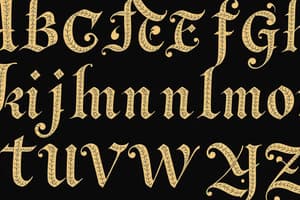Podcast
Questions and Answers
What is essential for the readability of letters in terms of spacing?
What is essential for the readability of letters in terms of spacing?
- Spacing must not be too close or too wide apart. (correct)
- Spacing must be very wide apart.
- Spacing should vary based on the letter.
- Spacing should be consistent for all letters.
Which of the following letters is the narrowest compared to others in the alphabet?
Which of the following letters is the narrowest compared to others in the alphabet?
- O
- M
- W
- I (correct)
Which letters can be used as standards for spacing?
Which letters can be used as standards for spacing?
- W and Y
- M and N
- I and O (correct)
- A and E
What characteristic differentiates letters in the alphabet?
What characteristic differentiates letters in the alphabet?
What shape does block lettering resemble?
What shape does block lettering resemble?
What is the first step in the construction procedure for lettering?
What is the first step in the construction procedure for lettering?
Why are block letters preferred for advertisements?
Why are block letters preferred for advertisements?
How much space should be given between squares when constructing lettering?
How much space should be given between squares when constructing lettering?
Which letters are wider than the standard square measurement?
Which letters are wider than the standard square measurement?
What are the groups into which letters are classified?
What are the groups into which letters are classified?
Flashcards are hidden until you start studying
Study Notes
Lettering
- Lettering is the artistic process of creating words and alphabets in specific styles.
History and Origin
- Alphabetic writing began in the 2nd millennium BCE with a consonantal system for Semitic languages in the Levant.
- Proto-Sinaitic script evolved in Ancient Egypt for Semitic-speaking workers.
- Egyptian writing, known as Hieroglyphics, incorporates pictures that can represent ideas or sounds.
- Cuneiform was the writing system used in ancient Babylon.
- Phoenicians and Greeks refined earlier scripts, introducing vowels into the alphabet.
- Romans standardized the letters A-Z and added symmetry, leading to the modern Roman alphabet.
- The first printing machine was developed in 1450 A.D. by Johannes Gutenberg in Mainz, Germany.
- Letter forms are categorized as majuscule (uppercase) and minuscule (lowercase).
Cases of Letters
- Uppercase letters (majuscule) are stored in higher cases compared to lowercase letters (minuscule).
- Ascenders are parts of lowercase letters that extend above the standard height, while descenders extend below.
Parts of a Letter
- Letters are classified based on their construction, such as block letters and scripts.
The Blocks
- Block letters are typeset and include various fonts.
- Serifs are ornamental projections on block letters, suitable for printed materials like textbooks and newspapers.
The Scripts (Pen Lettering/Calligraphy)
- Scripts are freehand letters made using calligraphic pens, divided into categories based on style.
Qualities of Good Lettering
- Simplicity: Should be straightforward to avoid boredom and attract attention.
- Suitability: Forms must align with their intended purpose, emphasizing arrangement.
- Legibility: Letters must be easy to read and organized without losing aesthetic beauty.
- Good spacing: Proper spacing balances letters to enhance readability; too close or too far diminishes clarity.
Uses of Lettering
- Letters serve a variety of communication and artistic purposes across different mediums.
General Lettering Proportion
- Each letter has distinct proportions; for example, 'I' is the narrowest while 'W' is the widest.
- Generally, letters share the same height but vary in width.
Grouping of Letters
- Letters can be categorized into various shapes such as wide, round, narrow, and medium.
Block Lettering
- Block letters resemble rectangular shapes, making them preferred for advertisements due to their clarity and adaptability.
Construction Procedure
- Begin with two parallel horizontal lines on a sheet of paper.
- Divide these lines into squares measuring 5 cm each, leaving a 0.5 cm gap between squares.
Studying That Suits You
Use AI to generate personalized quizzes and flashcards to suit your learning preferences.



